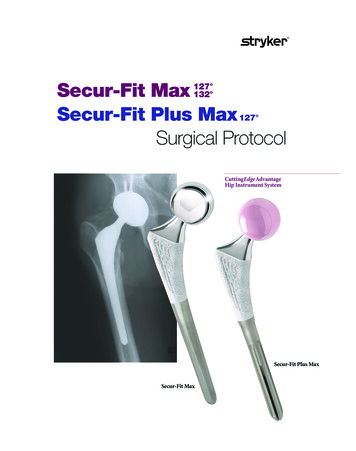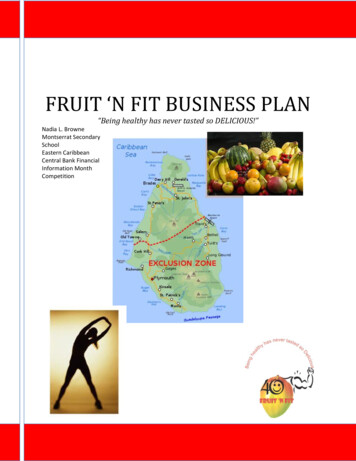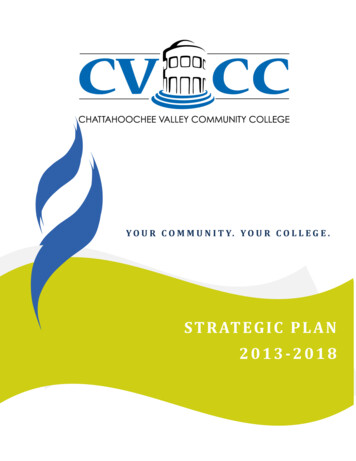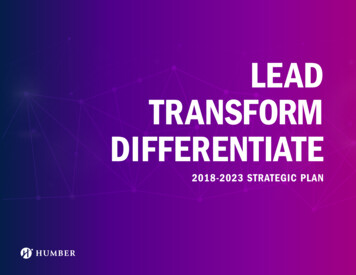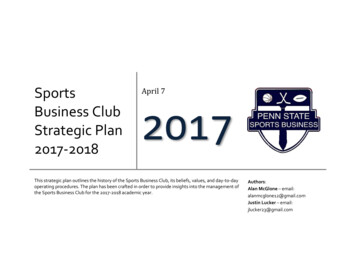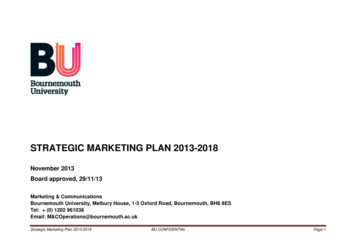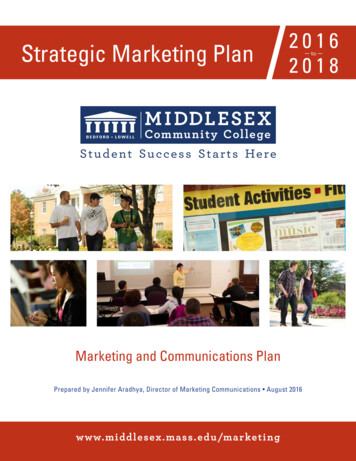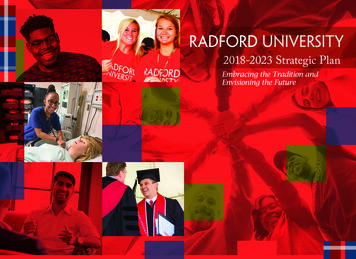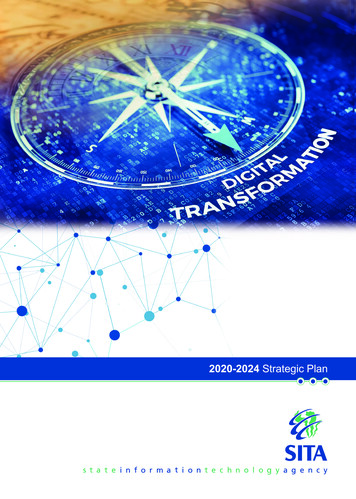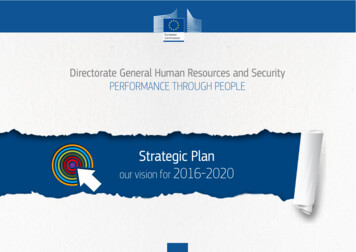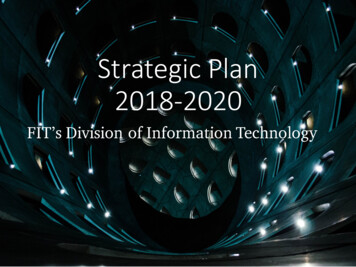
Transcription
Strategic Plan2018-2020FIT’s Division of Information Technology
CIO PerspectiveStrategic plans document the objectives that an organization wants to achieve over a specified period of time in response toits changing environment. For IT, the strategic plan is part of the resurgence of the IT Division post the Deloitte study,completed in early 2016. Over the past two years there has been significant improvement in the IT Division’s innovation,delivery of customer service, project management, and the overall contribution to the College’s mission and goals. Theturnaround is the direct result of IT teamwork and the determination by every member of the Division to meeting IT’sstrategic and operational goals. Additionally, the Division has received unwavering support for the turnaround actions fromthe President, Cabinet, and the FIT community.Faculty and students are accustomed to the rapid pace of digital service improvements coming from private industry. Theseconstituents then naturally expect a similar pace of improvements from FIT in the form of equipment and services thatremain current, accessible, and digital if at all possible. This means that the College requires a technology architecture thatpermits the assimilation of newer technologies, leverages Cloud based services, is appropriately maintained, improvesaccess to information, supports the digitizing of workflows, and protects the data entrusted to the College.The IT Strategic Plan represents our dedication to the continuous improvement of thought leadership and delivery of ITservices in support of the College’s strategic goals.2
IT Mission StatementTo develop and deliver technology services thatadvance the academic, student, innovation, andstrategic goals of FIT.3
Discussion TopicsStrategic Plan OverviewOperational ExcellenceInformation SecurityIT WorkforceDevelopment Emerging Technology Next Steps 4
Strategic Plan Key Themes1. Service improvement is a continuous process2. The pace of technology change continues to accelerate3. Transformation is occurring across Higher-Ed to address thechallenges of competition, better engagement with non-traditionalstudents, lower enrollment, and the digitization of workflows toimprove operating efficiencies and student services.4. Collaborate with Schools, Departments, and Faculty to assist withleveraging technology as part of their curriculum5. Resources – People, Space, Financial – are limited or shrinking5
Strategic Plan Life CycleFITSTRATEGICGOALSPLANNING/ASSESSMENTIT Strategic PlanEvolves fromGoals to S6
IT Strategy InfluencersExternal Influencers Digital EcosystemAvailability of ResourceOptionsSUNY and RegulatoryRequirementsVendor Marketplace*Academic collaboration withIndustry PartnersEmerging Technologies Internal Influencers FIT Strategic Goals Digital Workflows Pursuit of OperationalExcellence FIT Community TechnologyInnovation Initiatives ITSTRATEGICPLAN*See Appendices, Page 307
FIT Strategic Goals Drive IT Strategic PlanThe IT Strategic Plan supports the College’s goals by establishing a robust capacity toleverage emerging technologies, ensuring a skilled workforce, protecting FIT’s intellectualcapital, and delivering accurate effective and measurable operational results.FIT Strategic Goals*Goal 1: Ensure Academic and CreativeExcellenceGoal 2: Be an Innovation Center forCreative Industries WorldwideGoal 3: Provide an Empowering StudentExperience in a Cohesive CommunityBuilding a Powerful BrandIT Strategic Objectives*Objective 1: Operational ExcellenceObjective 2: Information SecurityObjective 3: IT Workforce DevelopmentObjective 4: Emerging Technologies* As the FIT Strategic Goals are periodically revised, the IT Strategic Objectives will be reviewed to ensure alignment.8
FIT IT Strategic Plan ObjectivesObjective 1:Operational ExcellenceObjective 2:Information SecurityEnsure operational technologies,talent, and processes that supportthe College remain effective,efficient, and measurable.Protect the confidentiality, integrity,and availability of data, research,and systems, to enable the FITcommunity to pursue its goals.PlanObjectivesObjective 3:IT Workforce DevelopmentObjective 4:Emerging TechnologiesEvolve the IT Division’s skillsets andcapabilities to align with theCollege’s strategic goals.Embrace emerging/advancedtechnologies to support academics,research, and innovation.9
Operational Excellence10
Operational ExcellenceSituation In addition to Deloitte’s 19 recommendations (across 4 categories), the ITDivision was not addressing application and infrastructure upgrades, disasterrecovery, and championing new technologies to address moving the College todigital workflows. The IT Division spent the latter half of 2016 and first half of 2017 identifying andbuilding consensus on how to address the system and infrastructure issues.Remediation Plans to address the critical operational issues have been established and are inprogress: Banner upgrade, MyFIT upgrade, Argos Implementation, OneSolutionupgrade, Data Center Move, Network upgrades, Event Space AV upgrades, andmigration of phone services to the Cloud.11
Operational Excellence Strategic PlanInitiatives Continue programs to upgrade/replace end of life systems,infrastructure, and processes Continue developing the skills necessary to support FIT’s evolvingTechnology Operations Implement standardized processes to protect and support FIT’sTechnology Operations Expand the use of Digital Workflows across the College to improveoperational efficiencies Establish Kaufman Hall as a local DR Site for many criticalapplications Leverage ITEC services and other cloud services to move FIT systemsto a lower cost location outside of New York City; this will also helpcreate additional disaster recovery capabilities12
Operational Excellence Timeline(timeline represents estimated start and completion of projects)20172018IT Governance Project2019Migrate Phone System to Cloud2020Develop Customer Engagement StrategySeamless User ExperienceIT Strategic Plan CreationBanner On-going Process Re-engineeringBanner Self-Service UpgradeBanner UpgradeEstablish DR RTOSuccession Planning & Knowledge TransferNetwork UpgradeDigital WorkflowsArgos BIEnhance IT BudgetSubmissionLuminis 5 UpgradeEthos Identity ManagerData Center Move25 Live ReviewRe-engineer Data Backup ArchitectureAll High, Medium & Low Priority Technology ProjectsImplement structure, processes andtoolsNolij to BDMEnhance IT Asset Mgt. PracticesAlign Job TilesEvent Space A/V UpgradesNew Advancement SystemCCPS CRMITEC PilotRationalize Duplicative & Outdated ApplicationsITEC MigrationAdjunct Computer/Classroom Peripheral Equipment RefreshesParticipate in Infrastructure Activities Associated with Physical Plant Renovations/NABMajor FIT initiatives will span over a course of several years and will require commitment fromboth IT and the college to bring about the desired capabilities.Text in this colorareDeloitte Recommendations13
Information Security14
ELEMENTSOF ATIONSINCIDENT RESPONSESee the IT Security Strategic Plan for More Information15
Information Security Strategic PlanGOAL*INFORMATION SECURITY IMPLICATION*Ensure Academic and CreativeExcellence Be An Innovation Center for CreativeIndustries Worldwide Provide An Empowering StudentExperience in a Cohesive CommunityBuilding a Powerful Brand FIT creates valuable intellectual property that must beprotected.As technology becomes engrained in the industries that FITserves (e.g. wearable technology), it must be secured.FIT will be responsible for protecting more partnerinformation.Partnerships and remote learning require informationprotection on a global stage.An empowered, diverse community creates and sharesmore information that must be protected.An empowered, diverse community creates attractivetargets for cyber attack.* As the FIT Strategic Goals are periodically revised, the IT Information Security Strategic Plan will be reviewed for alignment.16
Security Strategic Plan ePolicyInitial Policies and PracticesData ClassificationAudit Plan and ExecutionBrandingMessage PointsAwarenessFaculty/Staff Education ProgramStudent Education ProgramWhite Hat PhishingScreen Prot. for InactivityReduction in Admin PrivilegesRemoving VulnerabilitiesInfrastructureWorkstation ImagingServer ImagingNext Gen Anti VirusNetwork SecurityLogging and Event CorrelationDatabase Activity MonitoringApplication Assessment ProgramApplicationsSecure Coding TrainingDenial of Service Protection/WAFIncidentResponseForensics VendorIncident Response PlanTabletop Drills (Continually Revised and Customized)17
Workforce Development18
Workforce DevelopmentAnyone Can Buy the Tools; Attracting, Developing, and Retainingthe Right Talent is the Hard PartWhere are the available skills? –Internal? – Partners? – Vendors?Technology19
IT Skills and Coverage Current State IT has not traditionally invested in the technical and professional skillsdevelopment of team members. The relentless pace of changing technology requires an ongoingprogram to train IT personnel. Technical skills quickly become dated andneed to be refreshed/upgraded. The IT Division increasingly lives in a 24x7x365 world as a result ofmaintenance to systems and infrastructure, expectation of “always on”systems, international footprint, and the response to cyber-threats.20
IT Skills Gap* AnalysisSolution Design and DeliveryProject ManagementDebugging /TroubleshootingBusinessSensor TechnologyAugmented RealityIntelligence & DataAPI’sReportingAnalyticsSecurity AwarenessMobile/Web UICustomer SupportGovernanceBusiness AnalysisDevelopmentVirtual RealityDisaster RecoveryCollaborationTechnologiesDatabase ManagementEmerging TechnologiesTestingNetwork ArchitectureImportance to IT Strategic PlanLeadershipConfiguration ManagementService ManagementApplication SupportBig Data AnalysisInfrastructure/Data Center OperationsCoding & ProgrammingTechnical WritingIT Skills Gap*Skills are defined in the appendices21
Action Plan to Close Skills &Coverage Gap Cross TrainingExpands skill sets, extends knowledge to other team members, helps with succession Classroom-Based Training/WebinarsImprove and expand technical and professional skill sets Conferences/SeminarsGain knowledge on latest technology and trends, engage in peer discussions/reviews/networking New HiresEnhance the team with new perspectives and skills Cloud ServicesLeverage highly experienced resources to deliver economical and industry best practiceservices to increase support coverage for targeted areas (e.g., cyber attacks, hosting ofapplications)22
Emerging Technologies23
Emerging Technologies ExamplesAdvanced SecurityInternet of Things (IoT)At the center of all these technologies, issecurity. It must be fluid, adaptive anddetailed. Future security technology mustleverage machine learning to recognize andstop threats that evolve very quickly, and tonotify appropriate parties about events.Smartphones, wearable devices, tabletsand desktop computers can connect toappliances and sensors in and out of theworkplace. You can communicate withyour mobile device to the printer in theoffice; or even the coffee machine.Robots can aid with remote procedures such as medical care, ordo things humans simply cannot—carry items at a warehouse,military operations or even underwater ship maintenance. We willsee more robots in our daily lives, whether it’s a robot deliveringroom service, or taking over building security.Artificial Intelligence (AI)will reshape the workplace, allowingsystems that can comb throughmassive amounts of data. AIapplications are already being used toadjust marketing campaigns basedon signals from a target group.Telepresence, Virtual Reality, Augmented RealityAdvanced Collaborative ToolsOnline meeting and presentation software allows you to have ameeting with anyone who has an Internet connection. Users inmultiple locations can see the same document at the same time.Virtual Reality allows us to show business concepts in morerealistic terms, for example, walking through an office remodel ortraveling through a patient’s brain to find a tumor.How can you keep everyone on the same page, when they’re milesapart? Advanced Collaborative Tools helps individuals collaborate nomatter where they are located. Cloud-based documentmanagement provides a secure place to store, organize and shareinformation from any device. And telepresence robots give you asense of physically being in the office.24
Emerging Technologiesare relevant to how FIT engages withindustry on the use of the technologies in design, manufacturing, marketing/communications, etc.Source: CEB IT Leadership Council Survey of 260 Companies - 201725
FIT Emerging Technologies Timeline20172018Create an EmergingTechnology Committee20192020Meet Regularly to Approve Strategy, Governance and other Major IT ActivitiesPilot Emerging Tech withfaculty (Drones, VR, AR)Pilot Emerging Tech withCollege business operationsAssist faculty with the inclusion of Emerging Tech in their curriculumExpand use of Emerging Tech for College business Operations (AR, VR, etc.)Establish and nurture a Faculty Research and Innovation space to experiment with 3D Printers, 3DScanners, Drones, VR, AR and other Emerging Technologies as they become availableInstitutionalize Real-Time Collaboration (UC&C) resources and bestpracticesCreate a Technology &Keep all IT Faculty, Staff and AdministrationCollaboration ForumInformed on all Important FIT IT MattersIntroduce AdvancedCollaboration toolsMajor emerging technology initiatives will span several years and will require commitment fromboth IT and the College to bring about the desired results.26
Next Steps Review IT Strategic Plan Present Plan to the College President and Cabinet for feedback andapproval Review plan with Faculty Senate Executive Committee and Deans Communicate IT Strategy Broadly Customize communications for stakeholders e.g., Faculty, Staff,Students, External Parties Publish to FIT IT Website Align individual IT staff goals and incentives to overall strategy Monitor and Adapt IT Strategy Adapt IT strategy, as necessary, to changing conditions at FIT and in theacademic and technology environments27
Appendix28
IT SWOT AnalysisSTRENGTHSWEAKNESSES Strong institutional support for the ITDivision IT Division has deep knowledge of thetechnologies supporting FIT business andacademic operations Team members committed to FIT’s successand goals Strong innovation mindset Many critical systems are past end of life Development of IT staff has lagged behindthe advancement of technologies that willsupport the strategic goals of the College Limited ability to mine the wealth ofinformation in FIT systems Staffing model does not support therequired depth and breathe of skills setsand operationsOPPORTUNITIESTHREATS Enabling the FIT digital ecosystem –workflows, student experience, etc. Leveraging emerging technologies to advancethe strategic goals of the college Engaging with SUNY ITEC and other Cloudvendors to enable economies of scale and toimprove disaster recovery capabilities Engaging with faculty and students to identifyand deliver state of the art educationaltechnology Information security breaches Location – FIT’s primary computingprocessing capabilities are in one location Very limited disaster recovery capabilities Expected loss of institutional knowledgeas a result of team member retirements Retaining funding for critical technologyinitiatives Continued use of obsolete technology/29applications
THE HIGHER EDUCATIONAL TECHNOLOGY AND VENDOR LANDSCAPE IN 2018(The Challenge is “What’s Best for FIT?”)30
Descriptions of Skills in Gap AnalysisSkillAPIsApplication SupportAugmented RealityBig Data AnalysisBusiness AnalysisBusiness Intelligence(BI) & Data AnalyticsCoding onManagementDefinitionApplication code that allows computer programs, either custom-developed or 3rd-party, to interact with each other ina standardized way, so that existing components or products that perform specific functions can be combined toprovide an overall solution.Modifying FIT-developed programs or configurations of 3rd-party software to improve functionality and/or correctbugs and unexpected behavior.Technology that superimposes a computer-generated image or information on a user's view of the real world, thusproviding a composite view.The ability to ingest, link, and computationally analyze extremely large disparate data sets, both structured andunstructured, to provide new insights and advance decision making capabilities through data patterns, trends, andassociations.Ability to capture, interpret and document business needs and recommend solutions that deliver value tostakeholders. Solutions often include software or system components, but may also consist of process improvement,organizational change or policy development.A suite of skills and abilities needed to design, build, and deliver complex BI solutions that enable business users, viaself-service, to understand how a business area is performing and what can be done to meet their strategic oroperational goals. BI solutions generally bring together a diversified set of business data across multiple domains, andemploy data architecture, data warehousing, data transformation, master data management, and BI design andtechnology skills to develop solutions for business areas.Ability to design and develop software applications for a specific user or group of users within an organization,addressing their needs more precisely than off-the-shelf software.Unified Communications is an evolving set of technologies that automates and simplifies the interaction betweenhumans and audio/visual device activities. Unified Communications is a powerful tool to enable collaboration acrossgeographic boundaries.Tracking the hardware and software that make up the IT environment, understanding the relationship among thecomponents and their expected lifecycle, and executing changes in a reliable and repeatable manner.31
Descriptions of Skills in Gap AnalysisSkillCustomer SupportDatabase ManagementDebugging /TroubleshootingDisaster rshipMobile/Web UIDevelopmentNetwork ArchitectureProject ManagementDefinitionThe ability to take requests for repairs or new functionality from IT customers, to properly set expectations andwhen those requests will be filled, to pass them off to the team that can fulfill them, and to track requests toensure follow up.Ability to perform database administrator duties to ensure that a database is available, reliable, performant,monitored, secured according to business and regulatory rules, and managed for growth, upgrades andpatches. Keeps apprised of new releases and features to work with IT and business community to implementvalued features.Ability to evaluate a situation in which an IT system is not functioning as expected, understand the potentiallyincorrect components, determine the source of the problem, and remediate.Ability to document the business requirements to restore IT systems in the event that a major event disablesthe data center or a large portion of it, or a vendor system that is critical to the College. Further, design the ITenvironment so that it meets these business needs and conduct tests to make sure the design works asexpected.A set of practices that provides guidance as to how work within IT is prioritized and executed, to providetransparency and predictability.Maintaining the physical environment in which FIT equipment operates. This includes climate control, powermanagement, and space allocation. This also includes repeatable tasks such as back
As technology becomes engrained in the industries that FIT serves (e.g. wearable technology), it must be secured. Be An Innovation Center for Creative Industries Worldwide FIT will be responsible for protecting more partner information. Partnershipsand remote learning require
